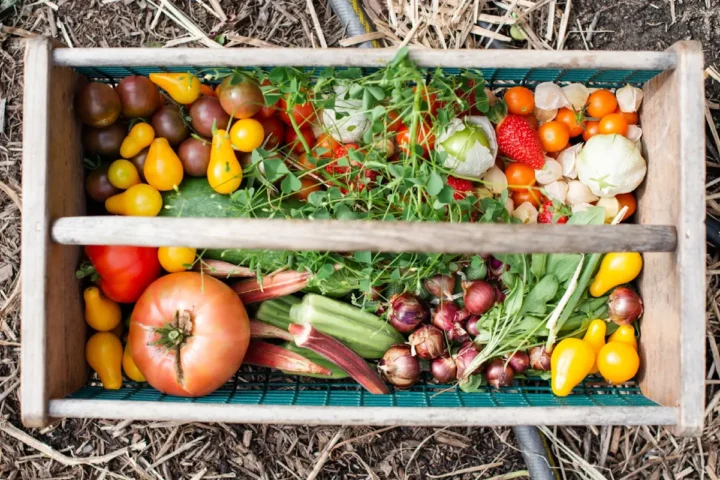Sustainable Practices in Fresh Produce Sourcing for Businesses
How can your business achieve sustainable sourcing of fresh produce?
The food industry must adopt sustainable sourcing practices as both food waste and environmental concerns continue to rise each year. Businesses can adopt eco-friendly methods for fresh produce sourcing to achieve environmental benefits.
- Reduce your business’s environmental footprint
- Lower operational costs
- Meet growing consumer demand for sustainability

The article presents actionable sustainable sourcing solutions that food businesses can start applying immediately.
What’s Inside:
- The Current State of Food Waste in Australia
- Benefits of Sustainable Fresh Produce Sourcing
- 7 Practical Strategies for Sustainable Sourcing
- Building Relationships with Local Suppliers
- Technology Solutions for Sustainable Sourcing
- Measuring Your Sustainability Impact
The Current State of Food Waste in Australia
Australia’s fresh produce supply chain faces a significant food waste issue.
Every year Australia sees food waste reach 7.6 million tonnes which represents approximately 312 kg per Australian citizen. The tremendous quantity of waste affects both environmental conditions and your financial outcomes.
The waste problem begins at the earliest stage before products even reach retail outlets.
- Fresh produce faces rejection rates between 20% and 40% before supermarket placement because it fails to meet the visual standards required by retailers and consumers.
- The production of fruits and vegetables results in 25% never reaching beyond the farm because of pest infestations, disease infections and damage from weather or handling.
Neither farms nor wholesalers alone are the sole contributors to this problem. According to household surveys 47% of homes throw away fresh vegetables and herbs while 33% discard fresh fruit every week.
But there’s some good news too.
Food businesses in Australia including manufacturers and major supermarkets Coles and Woolworths have cut their food waste by 13% since 2022 by participating in the Australian Food Pact. The reduction in food waste has prevented 505,000 tonnes of CO2 equivalent emissions which is similar to the impact of removing 210,000 cars from the roads for an entire year.
Benefits of Sustainable Fresh Produce Sourcing
Implementing sustainable practices when sourcing your wholesale fruit and vegetables doesn’t just help the planet — it can transform your business operations too.
These are the main advantages businesses gain from sustainable sourcing practices.
Reduced Costs: Effective waste reduction together with supply chain optimization leads to substantial financial savings across purchasing, storage and disposal costs.
Enhanced Brand Reputation: Today’s consumers care about sustainability. Companies that implement authentic environmental practices develop stronger customer loyalty and appeal to eco-aware consumers.
Improved Product Quality: Sustainable sourcing results in higher-quality and fresher produce because items usually travel shorter distances and experience fewer ownership changes.
Competitive Advantage: Set your business apart from others in a competitive environment by advertising your dedication to sustainable practices.
Risk Mitigation: Your business enhances its resilience to supply chain disruptions by diversifying suppliers and prioritizing local sourcing.
Next we will explore actionable strategies your business can implement.
7 Practical Strategies for Sustainable Sourcing
Are you prepared to transform your fresh produce sourcing into a sustainable operation? Here are seven strategies you can implement:
1. Embrace Imperfect Produce
Reducing waste becomes simpler when retailers reconsider their aesthetic standards.
Fruits and vegetables which possess minor blemishes or odd shapes along with slight discoloration remain perfectly edible but get discarded by traditional supply chains.
By accepting these “ugly” items:
- You can often negotiate better prices
- You help reduce farm-level waste
- Your establishment can develop distinctive dishes or promotional activities that emphasize your initiatives to cut down waste
2. Develop Flexible Menus and Recipes
Begin by selecting available ingredients before planning your menus.
- Develop seasonal menus using available local produce.
- Develop flexible recipes that can accommodate substitutions
- Train staff to adapt to seasonal availability
The method decreases waste and creates fresher and more unique options for customers.
3. Implement Just-in-Time Ordering
The practice of stocking too much inventory stands as a primary reason for food waste. Implement a just-in-time ordering system that:
- Uses historical data to predict demand
- Maintains smaller, more frequent orders
- Adjusts quickly to changing conditions
4. Prioritize Local Sourcing
Sourcing products locally helps lower transportation emissions and boosts your local economy. Benefits include:
- Fresher produce with longer shelf life
- Reduced carbon footprint from transportation
- Better relationships with suppliers
- Marketing opportunities highlighting local partnerships
5. Choose Suppliers With Sustainable Practices
Consider additional factors beyond pricing when choosing your fresh produce suppliers. Evaluate their:
- Water conservation methods
- Pest management approaches
- Soil health practices
- Energy use and carbon footprint
- Packaging choices
6. Optimize Storage and Handling
Appropriate storage and handling procedures extend product shelf life while minimizing waste generation.
- Select storage facilities that maintain optimal temperature and humidity conditions.
- Educate your staff about the correct handling methods for various kinds of produce.
- Implement a first-in, first-out (FIFO) system
- Regularly monitor inventory for items approaching expiration
7. Develop Waste Recovery Programs
No matter how well-designed systems are, generating some waste remains unavoidable. Develop programs to:
- Send edible products that cannot be sold to food rescue organizations for donation.
- Compost inedible organic waste
- Make the most of items by converting vegetable scraps into stocks.
- Establish collaborations with farms to provide food waste as livestock feed.
Building Relationships with Local Suppliers
Sustainable sourcing extends beyond simple transactions to develop meaningful relationships.
Forging robust relationships with local fresh produce suppliers yields advantages that extend beyond basic transactions.
Open Communication: Ongoing discussions with suppliers about their abilities and your requirements lead to improved planning processes while minimizing waste.
Collaborative Planning: Team up with suppliers to create crop planning and production schedules that deliver your required supplies consistently.
Long-term Commitments: Create extended purchase agreements with suppliers to provide them with financial stability while encouraging sustainable farming investments.
Fair Pricing: Paying fair prices that cover sustainable production costs leads to improved quality and reliability.
Technology Solutions for Sustainable Sourcing
Business sourcing methods for fresh produce are evolving through technological advancements to promote sustainability.
Inventory Management Systems: Contemporary systems provide demand forecasting and waste tracking capabilities which allow for optimized ordering processes that minimize surplus inventory.
Supplier Marketplaces: Businesses use digital platforms to establish direct connections with local farmers which eliminates intermediary involvement and decreases transportation needs.
Blockchain Traceability: Monitor produce movement from fields to consumers while maintaining sustainable supply chain practices.
Smart Storage Monitoring: Sensors and IoT devices ensure proper storage conditions while notifying staff about any potential problems.
The initial investment required for these technologies becomes worthwhile due to future savings from efficiency improvements and waste reductions that result in strong ROI.
Measuring Your Sustainability Impact
You can’t improve what you don’t measure. By tracking key metrics you can measure your advancement and discover areas that require improvement.
Waste Percentage: Monitor the fraction of bought produce that ends up as waste.
Food Miles: Measure the average distance your sourced produce travels from farm to business.
Carbon Footprint: Measure the greenhouse gas emissions that result from your sourcing practices.
Water Usage: Evaluate the water footprint of your sourced produce.
Cost Savings: Assess the monetary advantages gained through minimizing waste and improving sourcing efficiency.
Numerous companies establish sustainability dashboards to display their environmental metrics and establish their targets for improvement.
Wrapping Up Your Sustainable Journey
Sustainable fresh produce sourcing benefits both environmental health and business success. Following the strategies from this article enables businesses to minimize waste while saving money and developing better supplier connections that satisfy consumers who want eco-friendly operations.
Australian food businesses in the food industry decreased their total food waste by 13% since 2022 yet additional efforts remain essential.
Begin with minor adjustments to your processes and evaluate their effects before progressively scaling up your sustainable sourcing methods. The environmental and financial advantages will increase exponentially as time passes.
Which sustainable sourcing initiative will you start implementing first?


